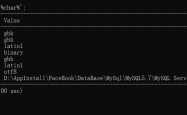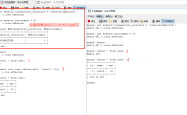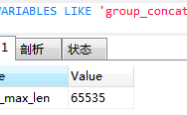深入理解r2dbc在mysql中的使用
吾爱主题
阅读:230
2024-04-02 08:00:00
评论:0
简介
mysql应该是我们在日常工作中使用到的一个非常普遍的数据库,虽然mysql现在是oracle公司的,但是它是开源的,市场占有率还是非常高的。
今天我们将会介绍r2dbc在mysql中的使用。
r2dbc-mysql的maven依赖
要想使用r2dbc-mysql,我们需要添加如下的maven依赖:
?
| 2 3 4 5 |
< dependency > < groupId >dev.miku</ groupId > < artifactId >r2dbc-mysql</ artifactId > < version >0.8.2.RELEASE</ version > </ dependency > |
当然,如果你想使用snapshot版本的话,可以这样:
?
| 2 3 4 5 6 7 8 9 10 11 12 13 14 |
< dependency > < groupId >dev.miku</ groupId > < artifactId >r2dbc-mysql</ artifactId > < version >${r2dbc-mysql.version}.BUILD-SNAPSHOT</ version > </ dependency > < repository > < id >sonatype-snapshots</ id > < name >SonaType Snapshots</ name > < url > https://oss.sonatype.org/content/repositories/snapshots </ url > < snapshots > < enabled >true</ enabled > </ snapshots > </ repository > |
创建connectionFactory
创建connectionFactory的代码实际上使用的r2dbc的标准接口,所以和之前讲到的h2的创建代码基本上是一样的:
?
| 2 3 4 5 6 7 8 9 10 11 12 13 14 15 |
// Notice: the query string must be URL encoded ConnectionFactory connectionFactory = ConnectionFactories.get( "r2dbcs: mysql://root:database-password-in-here@127.0.0.1:3306/r2dbc? " + "zeroDate=use_round&" + "sslMode=verify_identity&" + "useServerPrepareStatement=true&" + "tlsVersion=TLSv1.3%2CTLSv1.2%2CTLSv1.1&" + "sslCa=%2Fpath%2Fto%2Fmysql%2Fca.pem&" + "sslKey=%2Fpath%2Fto%2Fmysql%2Fclient-key.pem&" + "sslCert=%2Fpath%2Fto%2Fmysql%2Fclient-cert.pem&" + "sslKeyPassword=key-pem-password-in-here" ) // Creating a Mono using Project Reactor Mono<Connection> connectionMono = Mono.from(connectionFactory.create()); |
不同的是ConnectionFactories传入的参数不同。
我们也支持unix domain socket的格式:
?
| 2 3 4 |
// Minimum configuration for unix domain socket ConnectionFactory connectionFactory = ConnectionFactories.get( "r2dbc: mysql://root@unix?unixSocket=%2Fpath%2Fto%2Fmysql.sock " ) Mono<Connection> connectionMono = Mono.from(connectionFactory.create()); |
同样的,我们也支持从ConnectionFactoryOptions中创建ConnectionFactory:
?
| 2 3 4 5 6 7 8 9 10 11 12 13 14 15 16 17 18 19 20 21 22 23 24 25 26 27 |
ConnectionFactoryOptions options = ConnectionFactoryOptions.builder() .option(DRIVER, "mysql" ) .option(HOST, "127.0.0.1" ) .option(USER, "root" ) .option(PORT, 3306 ) // optional, default 3306 .option(PASSWORD, "database-password-in-here" ) // optional, default null, null means has no password .option(DATABASE, "r2dbc" ) // optional, default null, null means not specifying the database .option(CONNECT_TIMEOUT, Duration.ofSeconds( 3 )) // optional, default null, null means no timeout .option(SSL, true ) // optional, default sslMode is "preferred", it will be ignore if sslMode is set .option(Option.valueOf( "sslMode" ), "verify_identity" ) // optional, default "preferred" .option(Option.valueOf( "sslCa" ), "/path/to/mysql/ca.pem" ) // required when sslMode is verify_ca or verify_identity, default null, null means has no server CA cert .option(Option.valueOf( "sslCert" ), "/path/to/mysql/client-cert.pem" ) // optional, default null, null means has no client cert .option(Option.valueOf( "sslKey" ), "/path/to/mysql/client-key.pem" ) // optional, default null, null means has no client key .option(Option.valueOf( "sslKeyPassword" ), "key-pem-password-in-here" ) // optional, default null, null means has no password for client key (i.e. "sslKey") .option(Option.valueOf( "tlsVersion" ), "TLSv1.3,TLSv1.2,TLSv1.1" ) // optional, default is auto-selected by the server .option(Option.valueOf( "sslHostnameVerifier" ), "com.example.demo.MyVerifier" ) // optional, default is null, null means use standard verifier .option(Option.valueOf( "sslContextBuilderCustomizer" ), "com.example.demo.MyCustomizer" ) // optional, default is no-op customizer .option(Option.valueOf( "zeroDate" ), "use_null" ) // optional, default "use_null" .option(Option.valueOf( "useServerPrepareStatement" ), true ) // optional, default false .option(Option.valueOf( "tcpKeepAlive" ), true ) // optional, default false .option(Option.valueOf( "tcpNoDelay" ), true ) // optional, default false .option(Option.valueOf( "autodetectExtensions" ), false ) // optional, default false .build(); ConnectionFactory connectionFactory = ConnectionFactories.get(options); // Creating a Mono using Project Reactor Mono<Connection> connectionMono = Mono.from(connectionFactory.create()); |
或者下面的unix domain socket格式:
?
| 2 3 4 5 6 7 8 9 |
// Minimum configuration for unix domain socket ConnectionFactoryOptions options = ConnectionFactoryOptions.builder() .option(DRIVER, "mysql" ) .option(Option.valueOf( "unixSocket" ), "/path/to/mysql.sock" ) .option(USER, "root" ) .build(); ConnectionFactory connectionFactory = ConnectionFactories.get(options); Mono<Connection> connectionMono = Mono.from(connectionFactory.create()); |
使用MySqlConnectionFactory创建connection
上面的例子中,我们使用的是通用的r2dbc api来创建connection,同样的,我们也可以使用特有的MySqlConnectionFactory来创建connection:
?
| 2 3 4 5 6 7 8 9 10 11 12 13 14 15 16 17 18 19 20 21 22 23 24 25 26 27 |
MySqlConnectionConfiguration configuration = MySqlConnectionConfiguration.builder() .host( "127.0.0.1" ) .user( "root" ) .port( 3306 ) // optional, default 3306 .password( "database-password-in-here" ) // optional, default null, null means has no password .database( "r2dbc" ) // optional, default null, null means not specifying the database .serverZoneId(ZoneId.of( "Continent/City" )) // optional, default null, null means query server time zone when connection init .connectTimeout(Duration.ofSeconds( 3 )) // optional, default null, null means no timeout .sslMode(SslMode.VERIFY_IDENTITY) // optional, default SslMode.PREFERRED .sslCa( "/path/to/mysql/ca.pem" ) // required when sslMode is VERIFY_CA or VERIFY_IDENTITY, default null, null means has no server CA cert .sslCert( "/path/to/mysql/client-cert.pem" ) // optional, default has no client SSL certificate .sslKey( "/path/to/mysql/client-key.pem" ) // optional, default has no client SSL key .sslKeyPassword( "key-pem-password-in-here" ) // optional, default has no client SSL key password .tlsVersion(TlsVersions.TLS1_3, TlsVersions.TLS1_2, TlsVersions.TLS1_1) // optional, default is auto-selected by the server .sslHostnameVerifier(MyVerifier.INSTANCE) // optional, default is null, null means use standard verifier .sslContextBuilderCustomizer(MyCustomizer.INSTANCE) // optional, default is no-op customizer .zeroDateOption(ZeroDateOption.USE_NULL) // optional, default ZeroDateOption.USE_NULL .useServerPrepareStatement() // Use server-preparing statements, default use client-preparing statements .tcpKeepAlive( true ) // optional, controls TCP Keep Alive, default is false .tcpNoDelay( true ) // optional, controls TCP No Delay, default is false .autodetectExtensions( false ) // optional, controls extension auto-detect, default is true .extendWith(MyExtension.INSTANCE) // optional, manual extend an extension into extensions, default using auto-detect .build(); ConnectionFactory connectionFactory = MySqlConnectionFactory.from(configuration); // Creating a Mono using Project Reactor Mono<Connection> connectionMono = Mono.from(connectionFactory.create()); |
或者下面的unix domain socket方式:
?
| 2 3 4 5 6 7 8 |
// Minimum configuration for unix domain socket MySqlConnectionConfiguration configuration = MySqlConnectionConfiguration.builder() .unixSocket( "/path/to/mysql.sock" ) .user( "root" ) .build(); ConnectionFactory connectionFactory = MySqlConnectionFactory.from(configuration); Mono<Connection> connectionMono = Mono.from(connectionFactory.create()); |
执行statement
首先看一个简单的不带参数的statement:
?
| 2 |
connection.createStatement( "INSERT INTO `person` (`first_name`, `last_name`) VALUES ('who', 'how')" ) .execute(); // return a Publisher include one Result |
然后看一个带参数的statement:
?
| 2 3 4 5 6 7 8 9 |
connection.createStatement( "INSERT INTO `person` (`birth`, `nickname`, `show_name`) VALUES (?, ?name, ?name)" ) .bind( 0 , LocalDateTime.of( 2019 , 6 , 25 , 12 , 12 , 12 )) .bind( "name" , "Some one" ) // Not one-to-one binding, call twice of native index-bindings, or call once of name-bindings. .add() .bind( 0 , LocalDateTime.of( 2009 , 6 , 25 , 12 , 12 , 12 )) .bind( 1 , "My Nickname" ) .bind( 2 , "Naming show" ) .returnGeneratedValues( "generated_id" ) .execute(); // return a Publisher include two Results. |
注意,如果参数是null的话,可以使用bindNull来进行null值的绑定。
接下来我们看一个批量执行的操作:
?
| 2 3 4 |
connection.createBatch() .add( "INSERT INTO `person` (`first_name`, `last_name`) VALUES ('who', 'how')" ) .add( "UPDATE `earth` SET `count` = `count` + 1 WHERE `id` = 'human'" ) .execute(); // return a Publisher include two Results. |
执行事务
我们看一个执行事务的例子:
?
| 2 3 4 5 6 7 8 9 10 11 12 13 14 |
connection.beginTransaction() .then(Mono.from(connection.createStatement( "INSERT INTO `person` (`first_name`, `last_name`) VALUES ('who', 'how')" ).execute())) .flatMap(Result::getRowsUpdated) .thenMany(connection.createStatement( "INSERT INTO `person` (`birth`, `nickname`, `show_name`) VALUES (?, ?name, ?name)" ) .bind( 0 , LocalDateTime.of( 2019 , 6 , 25 , 12 , 12 , 12 )) .bind( "name" , "Some one" ) .add() .bind( 0 , LocalDateTime.of( 2009 , 6 , 25 , 12 , 12 , 12 )) .bind( 1 , "My Nickname" ) .bind( 2 , "Naming show" ) .returnGeneratedValues( "generated_id" ) .execute()) .flatMap(Result::getRowsUpdated) .then(connection.commitTransaction()); |
使用线程池
为了提升数据库的执行效率,减少建立连接的开销,一般数据库连接都会有连接池的概念,同样的r2dbc也有一个叫做r2dbc-pool的连接池。
r2dbc-pool的依赖:
?
| 2 3 4 5 |
< dependency > < groupId >io.r2dbc</ groupId > < artifactId >r2dbc-pool</ artifactId > < version >${version}</ version > </ dependency > |
如果你想使用snapshot版本,也可以这样指定:
?
| 2 3 4 5 6 7 8 9 10 11 |
< dependency > < groupId >io.r2dbc</ groupId > < artifactId >r2dbc-pool</ artifactId > < version >${version}.BUILD-SNAPSHOT</ version > </ dependency > < repository > < id >spring-libs-snapshot</ id > < name >Spring Snapshot Repository</ name > < url > https://repo.spring.io/libs-snapshot </ url > </ repository > |
看一下怎么指定数据库连接池:
?
| 2 3 |
ConnectionFactory connectionFactory = ConnectionFactories.get( "r2dbc:pool:<my-driver>://<host>:<port>/<database>[?maxIdleTime=PT60S[&…]" ); Publisher<? extends Connection> connectionPublisher = connectionFactory.create(); |
可以看到,我们只需要在连接URL上面添加pool这个driver即可。
同样的,我们也可以通过ConnectionFactoryOptions来创建:
?
| 2 3 4 5 6 7 8 9 10 11 12 13 14 |
ConnectionFactory connectionFactory = ConnectionFactories.get(ConnectionFactoryOptions.builder() .option(DRIVER, "pool" ) .option(PROTOCOL, "postgresql" ) // driver identifier, PROTOCOL is delegated as DRIVER by the pool. .option(HOST, "…" ) .option(PORT, "…" ) .option(USER, "…" ) .option(PASSWORD, "…" ) .option(DATABASE, "…" ) .build()); Publisher<? extends Connection> connectionPublisher = connectionFactory.create(); // Alternative: Creating a Mono using Project Reactor Mono<Connection> connectionMono = Mono.from(connectionFactory.create()); |
最后, 你也可以直接通过创建ConnectionPoolConfiguration来使用线程池:
?
| 2 3 4 5 6 7 8 9 10 11 12 13 14 15 16 17 18 19 |
ConnectionFactory connectionFactory = …; ConnectionPoolConfiguration configuration = ConnectionPoolConfiguration.builder(connectionFactory) .maxIdleTime(Duration.ofMillis( 1000 )) .maxSize( 20 ) .build(); ConnectionPool pool = new ConnectionPool(configuration); Mono<Connection> connectionMono = pool.create(); // later Connection connection = …; Mono<Void> release = connection.close(); // released the connection back to the pool // application shutdown pool.dispose(); |
到此这篇关于深入理解r2dbc在mysql中的使用的文章就介绍到这了,更多相关mysql r2dbc 内容请搜索服务器之家以前的文章或继续浏览下面的相关文章希望大家以后多多支持服务器之家!
原文链接:https://blog.csdn.net/superfjj/article/details/109919239











